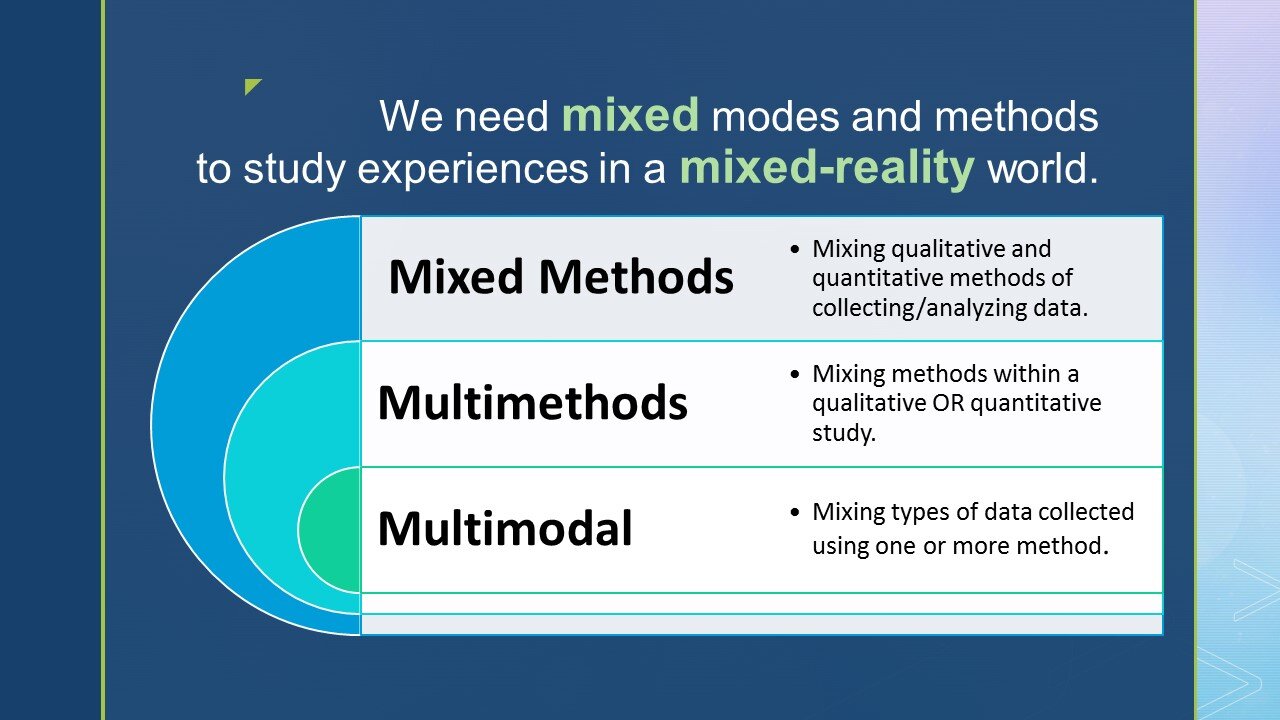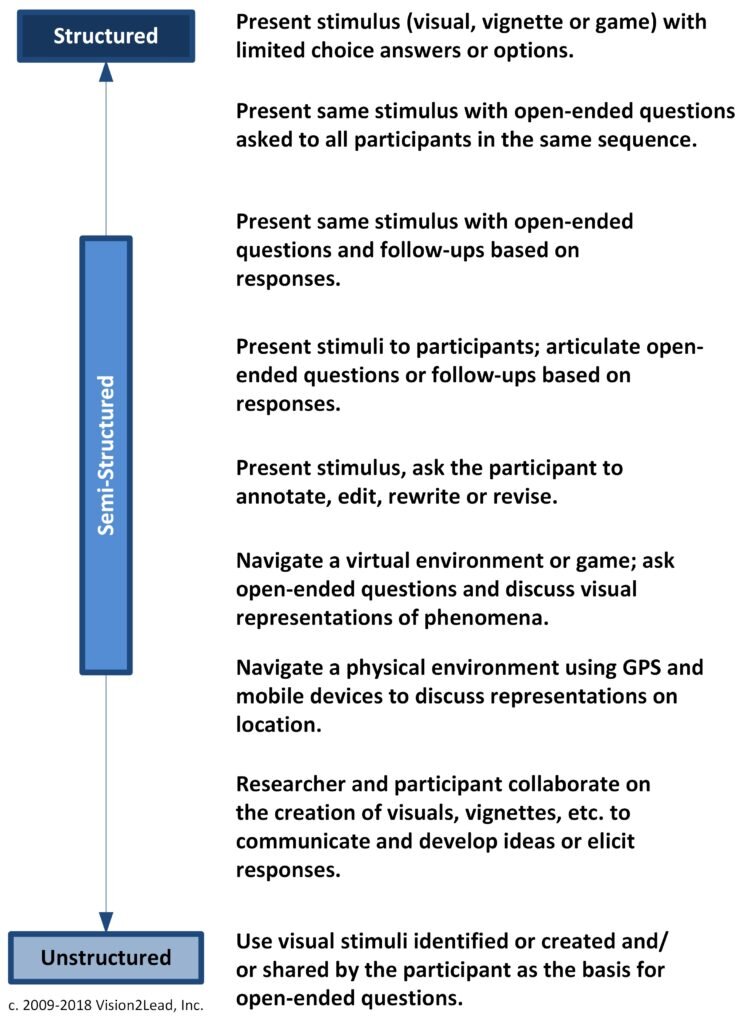Using Elicitation in Multimodal Studies
Multimodal studies use more than one type of data. To draw meaning from varied types, researchers might use more than one method to collect and analyze data. While the term mixed methods is used to describe studies that draw from both qualitative and quantitative research paradigms, the term multimethod refers to studies that use more than one approach within the same paradigm. A multimodal study could use a single method, multimethods, or mixed methods. The focus of this post is on qualitative multimodal research based on aural and visual data elicited through interviews; future posts will explore other options. How do we define elicitation techniques, what are some considerations for designing such a study? The following section is adapted from Chapter 6 in Qualitative Online Interviews and Chapters 8 and 9 from Doing Qualitative Research Online. These approaches can be conducted online, face-to-face, or can use technology to complement an interview conducted in-person.Elicitation InterviewsElicitation interviews allow for multimodal data collection because we generate a holistic understanding of the participants' experiences with inter-related visual, verbal, and in some cases text data. Visual elicitation refers to interviews that use images or media to stimulate discussion about participants’ experiences of the research phenomena. The term visual elicitation is used here to encompass the introduction of any kind of visual material into the interview, including photographs, videos, drawings, comics, artwork, diagrams or graphics, games, or recorded vignettes.Visual elicitation approaches use “artefacts employed during interviews where the subject matter defies the use of a strictly verbal approach” (Crillly, Blackwell, & Clarkson, 2006, p. 341). Goldstein points out that fruitful dialogue can take place based on the viewer’s response to the content, perception of intent, and context of the image (Goldstein, 2007. Stanczak (2007) describes an interview process:
The focus of this post is on qualitative multimodal research based on aural and visual data elicited through interviews; future posts will explore other options. How do we define elicitation techniques, what are some considerations for designing such a study? The following section is adapted from Chapter 6 in Qualitative Online Interviews and Chapters 8 and 9 from Doing Qualitative Research Online. These approaches can be conducted online, face-to-face, or can use technology to complement an interview conducted in-person.Elicitation InterviewsElicitation interviews allow for multimodal data collection because we generate a holistic understanding of the participants' experiences with inter-related visual, verbal, and in some cases text data. Visual elicitation refers to interviews that use images or media to stimulate discussion about participants’ experiences of the research phenomena. The term visual elicitation is used here to encompass the introduction of any kind of visual material into the interview, including photographs, videos, drawings, comics, artwork, diagrams or graphics, games, or recorded vignettes.Visual elicitation approaches use “artefacts employed during interviews where the subject matter defies the use of a strictly verbal approach” (Crillly, Blackwell, & Clarkson, 2006, p. 341). Goldstein points out that fruitful dialogue can take place based on the viewer’s response to the content, perception of intent, and context of the image (Goldstein, 2007. Stanczak (2007) describes an interview process:
In conjunction with or as an alternative to conversational questions, participants are asked open-ended questions about a photograph. Prompting a participant with ‘tell me about this photograph,’ for example, shifts the locus of meaning away from empirically objective representations of objects or interactions. Instead, images gain significance through the way that participants engage and interpret them. (pp. 10–11)
Rose (2016) points out that such interviews “can prompt talk about different things, in different ways" (p. 315). Observations, feelings, relationships, memories are discussed in ways that might be missed in talk-only interviews. By using these approaches, the image becomes a common frame of reference for both parties—researcher and participant. By sharing photographs or video, researchers and participants can visit other time periods or spaces it would be difficult for them to enter physically (Näykki & Järvelä, 2008). When the subject matter is of a sensitive nature, interviewee and interviewer can both turn to the visual image “as a kind of neutral third party” (Banks, 2017, p. 86).Participants who generate the visual material discussed in the interview have another opportunity to reflect on and experience the research phenomena by re-creating or reimagining it and then by explaining the image to the researcher during the interview (Rose, 2016). Creating or annotating diagrams or maps allows participants to use visual and spatial thinking and to explore possible solutions to problems (Buckley & Waring, 2013).Pink (2013) suggests that rather than simply “eliciting” or drawing out responses to the image or media, the researcher and participant can discuss images in ways that create a ‘bridge’ between their different experiences of reality. Photographs [graphics or media] can become reference points through which [researchers and participants] represent aspects of their realities to each other (p.84).Sources and Structure in Visual InterviewsTwo inter-related questions are important when designing multimodal visual elicitation interviews. One is: what is the source of the visual material. Another is: will the same visual material be used in all of the interviews?Visual representations of some aspect of the research phenomena can be generated by the researcher, by the participant, or obtained from other sources. When as researchers we select or create visuals, we can verify that we have permission to not only use them in the interview, but also to use them in presentations or publications based on the study. We can decide assemble a collection of visuals we can draw from for interviews depending on characteristics of each participant. Alternatively, we could create a set of visuals that we use in every interview. Depending on the nature of the study, we might want to invite participants to bring to the interview images or artifacts representing their own experiences and perceptions of their worlds. We could include a clause in the informed consent agreement related to permissions for use of such visuals in presentations and publications. In some situations images might include other people or locations that have not agreed to be a part of our study. In this case, the visuals are valuable in that they stimulate greater discussions with the participants, but cannot ethically be used in our findings and reports.Decisions about individuality versus consistency across a group of interviews are comparable to decisions about the level of structure we might use in a more conventional interview study. We can choose to ask the same questions, in the same order, in structured interviews, be open to far-ranging conversations in unstructured interviews, or take a middle ground with questions and prompts we vary depending on the participant and semistructured interview flow.What kind of multimodal study will you design?Use the comment area to share links to resources and examples, or to describe ways you have used multimodal approaches.Learn more about visual interviews conducted online: See related post with links to the articles: Multimodal Qualitative Research to Study Complex Problems ReferencesBanks, M. (2015). Visual methods in social research (2nd ed.). Thousand Oaks: SAGE Publications.Buckley, C. A., & Waring, M. J. (2013). Using diagrams to support the research process: examples from grounded theory. Qualitative Research, 13(2), 148-172. doi:10.1177/1468794112472280Crilly, N., Blackwell, A. F., & Clarkson, P. J. (2006). Graphic elicitation: Using research diagrams as interview stimuli. Qualitative Research, 6(3), 341-366.Goldstein, B. M. (2007). All photos lie: Images as data. In G. C. Stanczak (Ed.), Visual research methods: Image, society, and representation. Thousand Oaks: SAGE Publications.Näykki, P., & Järvelä, S. (2008). How pictorial knowledge representations mediate collaborative knowledge construction in groups. Journal of Research on Technology in Education 361, 40(3), 359-387.Pink, S. (2013). Doing visual ethnography (Third ed.). London: SAGE Publications.Rose, G. (2016). Visual methodologies: An introduction to researching with visual materials (4th Ed.). London: SAGE Publications.Stanczak, G. C. (2007). Visual research methods: Image, society, and representation. Thousand Oaks: SAGE Publications.
We can choose to ask the same questions, in the same order, in structured interviews, be open to far-ranging conversations in unstructured interviews, or take a middle ground with questions and prompts we vary depending on the participant and semistructured interview flow.What kind of multimodal study will you design?Use the comment area to share links to resources and examples, or to describe ways you have used multimodal approaches.Learn more about visual interviews conducted online: See related post with links to the articles: Multimodal Qualitative Research to Study Complex Problems ReferencesBanks, M. (2015). Visual methods in social research (2nd ed.). Thousand Oaks: SAGE Publications.Buckley, C. A., & Waring, M. J. (2013). Using diagrams to support the research process: examples from grounded theory. Qualitative Research, 13(2), 148-172. doi:10.1177/1468794112472280Crilly, N., Blackwell, A. F., & Clarkson, P. J. (2006). Graphic elicitation: Using research diagrams as interview stimuli. Qualitative Research, 6(3), 341-366.Goldstein, B. M. (2007). All photos lie: Images as data. In G. C. Stanczak (Ed.), Visual research methods: Image, society, and representation. Thousand Oaks: SAGE Publications.Näykki, P., & Järvelä, S. (2008). How pictorial knowledge representations mediate collaborative knowledge construction in groups. Journal of Research on Technology in Education 361, 40(3), 359-387.Pink, S. (2013). Doing visual ethnography (Third ed.). London: SAGE Publications.Rose, G. (2016). Visual methodologies: An introduction to researching with visual materials (4th Ed.). London: SAGE Publications.Stanczak, G. C. (2007). Visual research methods: Image, society, and representation. Thousand Oaks: SAGE Publications.
